A double-dose of Universal horrors, 1940s style. That, of course, means what we have here are a couple of slick B movies that were turned out assembly-line style by the second incarnation of the studio whose name is synonymous with horror. This era of Universal horrors is often termed the “silver age,” though “tin foil age” might be nearer the mark. Don’t get me wrong—these are fun little movies, blessed with actors, music and a studio look that make them seem more polished than they actually are. If you see James Hogan’s The Mad Ghoul (1943), that puts you one up on Hogan himself, who handed in his dinner pail shortly after finishing the film. (There are those who might consider him fortunate.) This is a pretty neat little horror picture that’s raised several notches by the presence of George Zucco as the openly lecherous mad scientist who turns David Bruce into the title monster—as much for a shot at leading lady Evelyn Ankers (he wants to teach her how to read “the book of life”) as for the good of science.

The results are actually pretty grisly for its era—and the Mad Ghoul looks alarmingly like a George Romero zombie. (Plus, there’s simian value.) An unnamed British critic is said to have reviewed the film by noting, “To be a ghoul would be disconcerting enough. To be a mad ghoul must be the height of personal embarassment.” Reginald Le Borg’s Weird Woman (1944) is the second in Universal’s brief Inner Sanctum series—six movies that present Lon Chaney Jr. in vaguely horrific mysteries. This one is actually based on a bonafide horror novel—Fritz Leiber’s classic Conjure Wife—with the horror given the bum’s rush in favor of spooky mystery. It retains the basis of the novel’s plot, however, and manages a good deal of atmosphere, though quite the scariest thing about it may be the idea of Chaney as a brilliant professor of anthropology. That’s also what makes it fun.
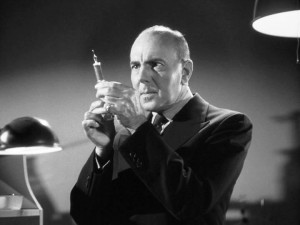
It’s a little unclear what Universal was up to with The Mad Ghoul. By 1943 they were clearly looking at their movies with an eye toward new franchises—yet there’s no hint that this ever was going to be anything but a one-shot affair. There’s no one left standing and no way to even pick up the basic idea by the end of the movie. While yielding the lamp of admiration for the ability of Universal script writers to wiggle out of just about anything to come up with a sequel, this one seems to be beyond resuscitation—unless, of course, they simply pretended the first one ended differently. Had it been a big hit (it wasn’t) that might have been tested. As it stands, it’s simply a grisly curio.
George Zucco is Dr. Alfred Morris, an obviously demented college professor who has unconvered some secret Mayan/Aztec/Incan (the very scientific script only calls them “natives”) poison gas that produces zombie-like results that can be reversed with the use of a human heart and 11 secret herbs and spices. He’s gleaned this, it seems, from perusing some pretty cheesy hieroglyphics (they look rather like Ernie Bushmiller might have drawn them in a macabre moment on a bad day between Nancy comic strips). The exact point of such a thing from the “native” standpoint is never made clear, but then the scientific prospects aren’t all that much clearer—at least apart from Dr. Morris wanting to take Isabel Lewis (Ankers) away from medical student Ted Alison (Bruce), and that’s something of an afterthought.
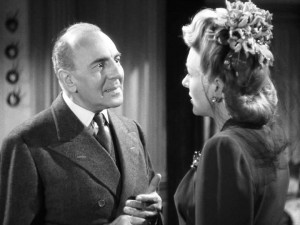
In any case, Dr. Morris has zombified a monkey and bamboozles Ted—a handy boob to have around when you need a cardiectomy, it seems—into opening up another simian and removing his heart. Of course, it works, otherwise there’d be no movie, though Ted does get to opine, “I can’t help feeling a sense of evil in all this.” It also follows that Morris wants to perform the same stunt on a human being. And since he has divined that Isabel has fallen out of love with the rather dull Ted—and mystifyingly thinks she’d prefer an older, more sophisticted man—Morris gases poor Ted, does some post-hypnotic (or post-zombie) suggestion on the boy concerning Isabel, and then takes him to the cemetery for some cardiectomy work on a nice fresh cadaver.
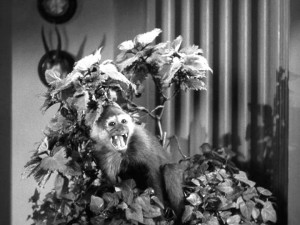
Naturally, there’s a slight twist to all this that ol’ Doc Morris didn’t figure out from the cartoonish hieroglyphics. Wouldn’t you know it? The effects of the restorative are temporary, spelling bad news for both the monkey and Ted. This, of course, leads us on a grave-robbing—occasionally murderous—cardiectomy spree. (The monkey, alas, is seemingly considered expendable and allowed to expire.) Worse—from Dr. Morris’ perpective—it turns out that he’s not the one Isabel wants teaching her how to read the book of life. That honor falls to the smarmy Turhan Bey at his brilliantined smarmiest. Naturally, this means the zombified Ted is going to be sent to dispatch him—and so it goes.
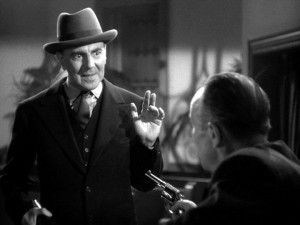
Yes, it’s all kind of silly, but it’s played agreeably straight, especially by Zucco, who had the uncanny ability to make his eyes seem to actually glow at the prospect of any piece of prime perfidy or lechery. He never reached the level of Karloff, Lugosi, or even Lionel Atwill as a horror star—and that probably suited him fine, since he wasn’t all that thrilled about appearing in these movies—yet he’s invariably a welcome genre presence. The film itself is a strange mix of the truly atmospheric and the appallingly flat. Hogan does a swell job with the graveyard and (decidedly low-rent) laboratory stuff, but he films the climactic showdown in such an offhand manner that it barely registers. Thank goodness, there’s a final scene with Zucco to bring the fim back to its senses.
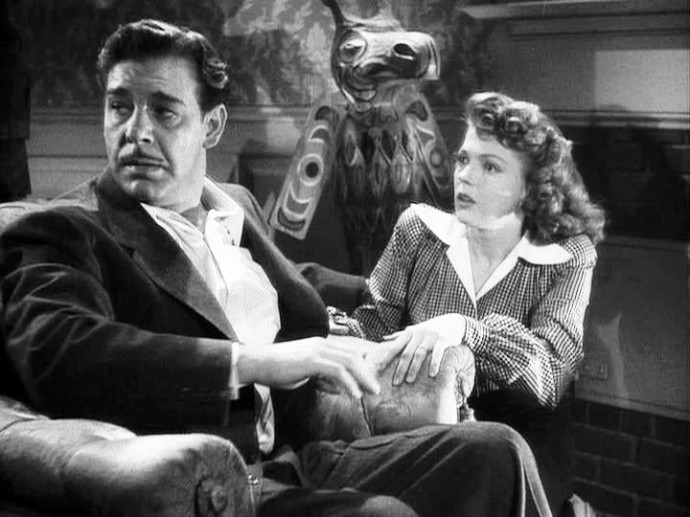
Fritz Leiber’s novel Conjure Wife (published in 1943 in Unknown Worlds magazine) is a true classic of horror fiction that has, as yet, never resulted in a faithful film version, despite having been adapted three times—this one, Burn, Witch, Burn (a U.S. retitling of Night of the Eagle and unrelated to to the A. Merritt novel, Burn, Witch, Burn, which was filmed in 1936 as The Devil Doll) in 1962 and Witches’ Brew (1980). Burn, Witch, Burn is highly regarded in some quaters, but it’s still far from the book. (That last named is at best a comedic “sort of” version.) This first one—while removing the outright horror elements—does preserve (and embellish) the basics. This is still about witchcraft in the American household. The book puts it that most—maybe all—women use witchcraft to help and protect their husbands. This reduces it to one woman and adds a fairly preposterous backstory. And it’s set in the world of New England academia.
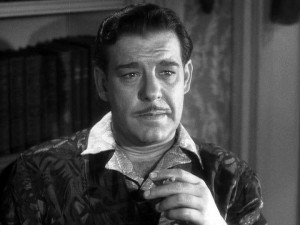
It seems curious that Universal—the home of horror—should milk the horror out of the book, but then certain things about the book would have been hard or impossible to film at the time. (An ambulatory stone dragon needed CGI, which it could get today.) Other things that could have been done would have taken longer and been more expensive than the week or two schedule of the programmer Universal had in mind. The idea of the “Inner Sanctum” series was to create a string of nothing-if-not-ecomical vehicles for their new 1940s horror star, Lon Chaney Jr. They may also have played to Chaney’s vanity since the films often preposterously cast him as an intellectual type (as does this one) who isn’t buried under make-up, but does get to sport an array of some of the most outrageous neckties in the history of fashion.
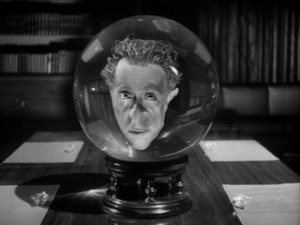
Most the films want to keep a horror notion going by being on the spooky side and featuring things like like hypnotism, wax museums, etc. The first five films were introduced by floating head—sometimes called “The Spirit of the Inner Sanctum” (an unbilled David Hoffman)—that informed viewers, “This is the Inner Sanctum—a strange fantastic world, controlled by a mass of living pulsating flesh: the mind. It destroys, distorts, creates monsters, commits murder. Yes, even you, without knowing, can commit murder!” This somewhat vague introduction really had nothing to do with the stories—except maybe for the last film, the one it wasn’t used on—but it attempted to set a tone of menace. The series seems to have been only marginally connected to Himan Brown’s radio program of the same name—Universal’s contract seems to have only been required to credit publishers Simon & Schuster, whose low-budget mystery novels had led to the radio show.
Chaney is about as believable as you’d expect—and it’s compounded by the series’ convention that his character tends to spend a lot of time “thinking aloud” via voice-over. It’s not simply that Chaney’s raspy, hushed delivery—apparently we think in whispers—but this sub-Eugene O’Neill device forces the poor guy to try and look like he’s deep in thought. At best, he looks vaguely uncomfortable and thinking about how soon he can possibly get back to his dressing room for a drink.
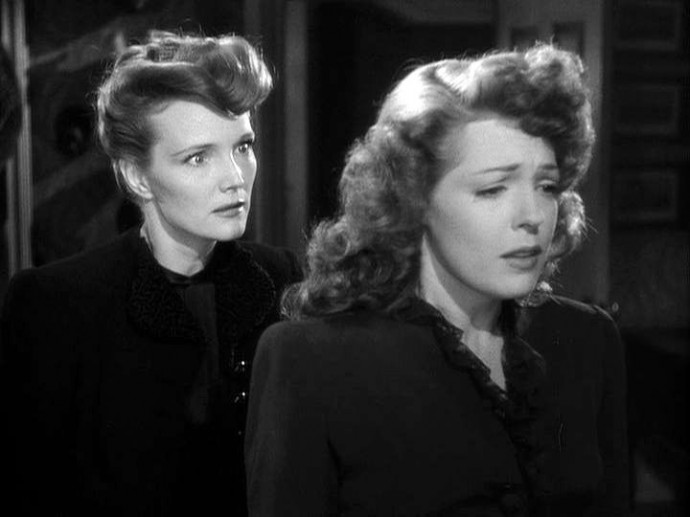
Overall, though, director Reginald LeBorg keeps the movie pretty effective on the atmosphere front, though the opening scenes may be the most effective of all. This was only LeBorg’s third feature and you can tell—much as with his previous film, the first Inner Sanctum, Calling Dr. Death (1943)—that he was seriously trying to prove himself. He never quite made it, though he kept churning out movies and TV shows for 30 years. Horror fans know him mostly for such 1950s fare as The Black Sleep (1956) and Voodoo Island (1957). Some have even forgiven him for those.




Before you comment
The comments section is here to provide a platform for civil dialogue on the issues we face together as a local community. Xpress is committed to offering this platform for all voices, but when the tone of the discussion gets nasty or strays off topic, we believe many people choose not to participate. Xpress editors are determined to moderate comments to ensure a constructive interchange is maintained. All comments judged not to be in keeping with the spirit of civil discourse will be removed and repeat violators will be banned. See here for our terms of service. Thank you for being part of this effort to promote respectful discussion.